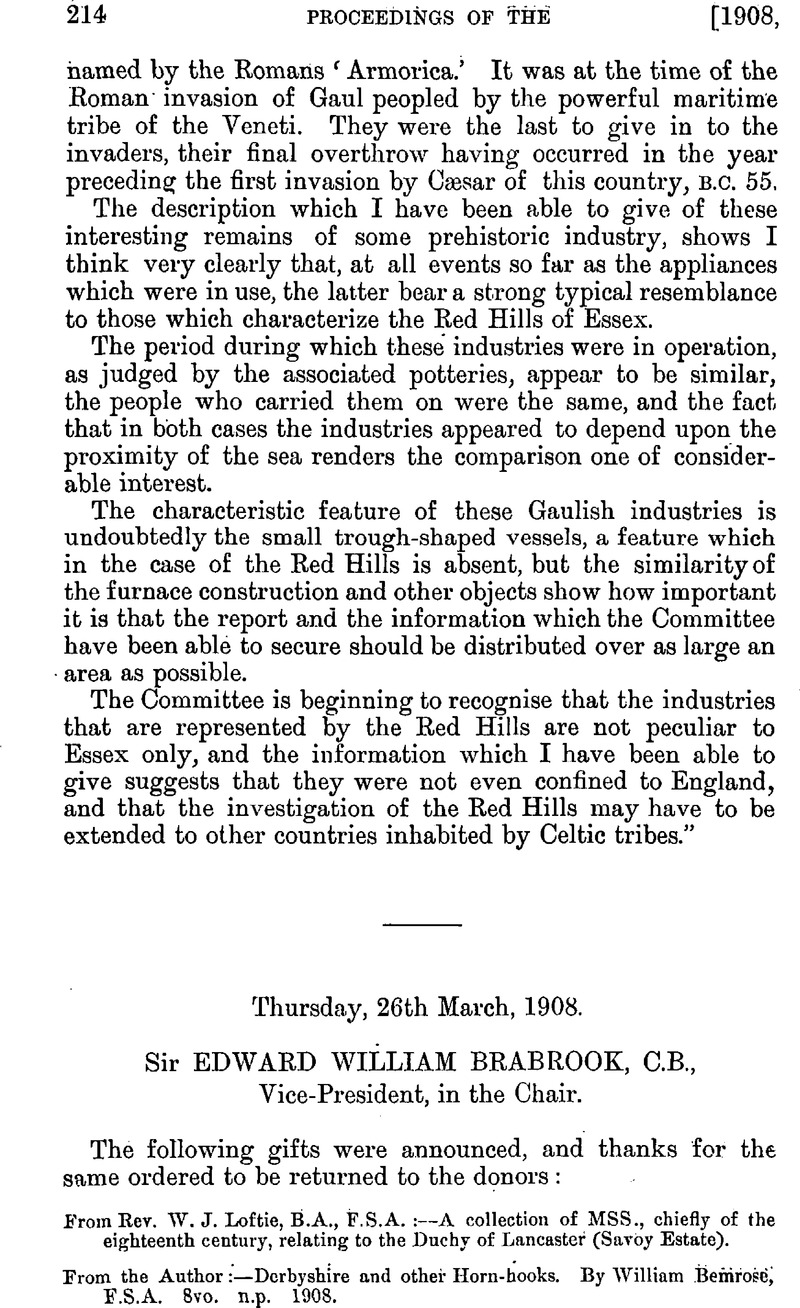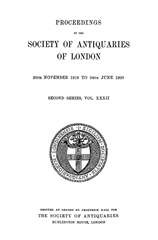No CrossRef data available.
Article contents
Thursday, 26th March, 1908
Published online by Cambridge University Press: 10 May 2010
Abstract

- Type
- Proceedings
- Information
- Copyright
- Copyright © The Society of Antiquaries of London 1909
References
page 215 note * Celtic Art in Pagan and Christian Times, 281. The square rectangular fret found on stone crosses at Penmon, Anglesey, and occurring along North Wales as far as Cheshire, has been attributed by some to Saxon rather than Celtic influence (Reliquary and Illustrated Archaeologist, iii. 109–112). At any rate it is rare in Celtic art.
page 215 note † On Rhodian vases, see A. Riegl, Stilfragen, 166.
page 216 note * This design should be compared with that frequently used as a background on Saracenic metal work made in Mesopotamia in the thirteenth century (fig. 2). The close similarity suggests that the Saracenic motive is really a survival from earlier times, like other elements in the complex which we describe as Mohammedan art.
page 218 note * Forms very similar to parts of the band on the Venice pilasters occur in the borders of Irish MSS., especially at the corners. E.g. miniature with the unidentified standing figure in the Book of Kells (reproduced by Stanford F. Robinson, Illustrative Art in the Gospel Books of Durrow, Lindisfarne and Kells). The borders of illuminations in the early Frankish Gospels of Godescale in the National Library at Paris may also be compared.
page 220 note * Darcel, A., Gazette des Beaux Arts, second period, xxiii. (1881), pp. 105–6 fig. (drawing) on p. 103Google Scholar. The reliquary is 39 centimetres high and 31 centimetres long. In general form it rather resembles the Ark of the Covenant on the tympanum of the west doorway at Notre Dame. Paris.
page 220 note † Catalogo del Reale Museo Nazionale di Firenze, 1898, Nos. 663, 664.
page 221 note * G. F. Warner, Reproductions from Illuminated Manuscripts in the British Museum, Series iii. pl. xix.
Mr. Yates Thompson's book, La Sainte Abbaye, is described by Dr. James in the catalogue of Mr. Thompson's collection, vol. i. No. 40.
page 222 note * See reproductions in Les Arts, January, 1906, p. 13, and July, p. 27.
page 223 note * G. Vitzthum, Die Pariser Miniaturmalerei von der Zeit des heiligen Ludwig bis zu Philipp von Valois, 224–236. The English affinities in the MSS., affecting both the figures and the ornamental motives, lend the group an exceptional interest.
page 225 note * E.g. MS. 9428 Bibliothèque Royale, Brussels (Cahier and Martin, Mélanges d'archéologie, ii. 49: (tenth century.);, ivory carving in the British Museum (twelfth century); stained glass window in Rheims cathedral church. In the Gothic period the small figure of Adam emerging from his tomb at the foot of. the cross occasionally fulfils the function formerly assigned to the personified Church, and holds a chalice to receive the blood from- Christ's side. This is the case in an English Psalter of the early fourteenth century in the British Museum.
page 225 note † The dimensions are 3 feet 2 inches in height and 2 feet 3 inches in breadth. All possible facilities for the examination of the sculpture were given by the Rev. A. E. Dalton, Rector of Stepney (now Rector of Clapham), who is keenly interested in the history and antiquities of Stepney Church.
page 225 note ‡ A small and very inaccurate engraving of this relief is to be found in the Gentleman's Magazine for August 1708, pp. 712–13. Mr.King's, H. W. etching in the Journal of the British. Archaeological Association, vii. 1852, pl. viGoogle Scholar. is a decided improvement, though even here the artist has not been altogether successful, misinterpreting details in rendering the body of Our Lord, and misunderstanding the figures in the medallions above the arms of the cross. The relief is mentioned in Lysons's Encirons of London.
page 226 note * St. Dunstan died in 988.
page 226 note † E.g. Hood over the. chancel door at Bolsover church, near Chesterfield, (Journal of the British Archaeological Association, vii. 1852, pl. xxx.)Google Scholar where the Virgin and St. John are present, but not the sun and moon ; twelfth century marble altar frontal of Saint Guilhem-du-Désert, a church between Lodève and Montpellier, where the general treatment of the Crucifixion is not unlike that of the Stepney relief (Le-Ricque de Monchy, Notice sur l'antel de St. Guilhem-du-Désert, 1857 ; Révoil, Architecture romane du midi de la France, vol. iii. ; L. Bégule. Les incrustations décoratives, etc. p. 40); early twelfth-century relief with the Descent from the Cross at Horn (F. X. Kraus, Geschichte der Christ lichen Kunst, vol. ii. p. 214) ; tomb of Saint Lazare, Autun (Monuments Piot, viii. 1902, pl. x) ; early twelfth-century drawing from a MS. in the cathedral church of Auxerre (Gazette Archéologique, xii. 1887, pl. xix.).
page 226 note ‡ Archaeologia, xxiv. pl. xi.
page 227 note * G. F. Warner, Reproductions from Illuminated Manuscripts in the British Museum, Series II. pl. vi. A very early example in metal-work is the gold cross of Lothair at Aix-la-Chapelle. Cahier and Martin, Mélanges d'archéologie, i. 1. xxxii.
page 227 note † E.g. British Museum, Colton, Tiberius c. vi. English Psalter of the eleventh century, fol. 114b. Cross held by Our Lord treading on the asp and basilisk Stowe, 944, fol. 6b. Martyrology, New Minster a.d. 1016–1020, cross carried by a priest.
page 227 note ‡ Sculptured capitals assigned to the fifth and sixth century at Daphni in Attica (G. Millet, Le Monastère de Daphni, fig. 2, p. 8). It may be noted here that the enclosed palmette appears to have been rarely adopted in Roman art, and this is one of the minor arguments which might be brought forward in favour of the Hellenistic (as opposed to Roman) origin of Romanesque.
page 227 note § Examples in R. Cattaneo, L'architettura in Italia dal 5 secolo al mille circa ; G. T. Rivoira, Le origini dell' architettura lombarda.
page 227 note ‖ E.g. Calvert, A. F., Toledo, London, 1907Google Scholar, pl. 438, fig. 2, etc.
page 227 note ¶ E.g. Codex Aureus, British Museum, Harley 2788, a.d. 800 ; Alcuin Bible, Add. MS. 10, 546, ninth century.
page 227 note ** E.g. Bishopsteignton, Devon (J. C. Cox, A History of English Church Furniture, 196.) Also at Fowey, Lanreath, Wolborough, Barnetby-le-Wold, etc. In the last example the variant used is like that on the great chandelier at Hildesheim.
page 227 note †† Cast in the Victoria and Albert Museum ; Archaeological Journal, xii. 409 ; M. Enlart (in A. Michel's Histoire de l'art, etc. ii. pt. i. pp. 201–2) assigns the reliefs to the twelfth century.
page 228 note * I believe the earliest example at present known of the use of a single nail with crossed feet occurs in a miniature in the Psalter of the Landgraf Hermann of Thüriogen now at Stuttgart, written and illuminated before the year 1217. (A. Haseloff, Eine Thüringisch-Sächsische Malerschule, etc. 149.)
page 228 note † The busts are not very easily made out. owing to the weathering of the stone, but I think no one familiar with early mediæval iconography will doubt the accuracy of the description. Mr. King (Journal of the British Archaeological Association, vii. 81) is certainly wrong in describing the figures as angels.
page 228 note ‡ Among the well-known ancient examples of Sol and Luna in their chariots are those on the Arch of Constantine at Rome, and the relation of these to later sculptures such as those on the Baptistery of Parma (Venturi, Storia dell' arte italiana, i. p. 49) has been remarked. Other examples of the Christian period are to be seen on the ivory diptych at Sens (E. Molinier, Ivoires, p. 47) on the Carolingian ivory book-cover in the Bibliothèque Nationale. Paris (Venturi, as above, ii. p. 189), and on a tenth-century ivory from Bamberg, now at Munich. The earliest appearances of the busts or heads of sun and moon at the Crucifixion occur on the metal ampullæ at Monza, and in the Syrian gospels of Rabula at Florence, all of the sixth century.
page 228 note § Haseloff, as above, p. 145, pl. xlix. In Gothic art the personifications disappear, though sun and moon are still often represented as faces. They no longer occupy such prominent positions, and, as in Byzantine art, their old places in the angles of the cross are constantly filled by angels. The discs or medallions in which the bust of sun and moon appear need not be regarded as representing their orbs. The light-giving powers are independently indicated in the case of the sun by a crown of rays, and of the moon by a crescent on the brow ; or again, by torches held by both. The medallions are rather intended to frame the subject, as in the imagines clypeatæ of classical art.
page 229 note * S. Beissel, Der heilige Bernward von Hildesheim, p. 16, pl. iii. On an early ivory, perhaps Rhenish, tenth to eleventh century, the body is also realistically treated. (Victoria and Albert Museum, photo. 14, 209.). Cf. also the early ivory at Manchester Art Museum. Cust, The Ivory Workers of the Middle Ages, 123.
page 229 note † Pictures of. the Crucifixion were known very early in England. Bede mentions a Crucifixion among the pictures brought from Rome by Benedict Biscop in a.d. 686.
page 229 note ‡ Both miniatures are given in Dr. Warner's Reproductions from Illuminated Manuscripts in the British Museum, Series II. pl. iv. and vii.
page 229 note § This treatment is based upon the account in the Gospel of St. John.
page 229 note ‖ E.g. Frescoes in Sta. Maria Antigua, diptych of Rambona in the Vatican, Encolpion at Monza, Lost Mosaic of Pope John VII. (Garrucci, Storia dell' arte cristiana, pl. 279–280—all between the the seventh and ninth centuries.
page 230 note * It is interesting to note that Dante gives this attitude to William of Navarre. (Purgatorio, I. vii.)
page 230 note † For remarks upon the descent of Christian gesture and attitude from classical types, see Dobbert, Jahrbuch der Königlich preussischen Kunstsammlungen, xv. 216 ff.
page 230 note ‡ She is so seen in the frescoes of the Liebfrauenkirche at Andernach, which date from the early thirteenth century. (P. Clemen, Die romanischen Wandmalercien.der Rheinlande, pl. xviii.)
page 230 note § E.g. in the Codex Egberti at Trier (about a.d. 1000. F. X. Kraus, Die Miniaturen des Codex Eglerbi, pl. xlix.) ; in the eleventh century frescoes of the Church of St. George at Oberzell (the same, Die Wandgemälde in der S. Georgshirche zu O. pl. xvi.), etc. etc.
page 235 note * On the Milan Ivories, see Venturi, figs. 388, 389, and p. 509.


